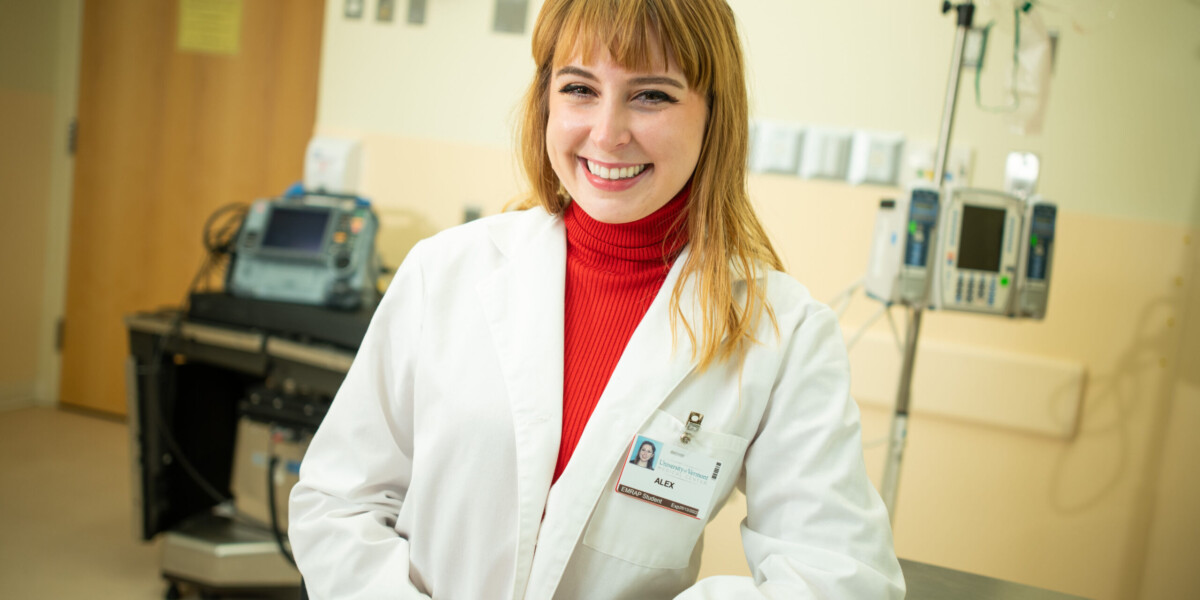Twenty-four hours a day, the University of Vermont’s Fabrication Laboratory, or Fab Lab, is buzzing with activity. You might not see any students lining up to design and build the next best thing, but judging from the back-to-back jobs in the queue for the 3D printer, there are a lot of ideas percolating.
“There might be five or six projects here at one time, but you don’t see anyone here waiting on their projects,” said Andrew Giroux, an electrical engineering undergraduate student at UVM and president of the student-run AERO (Alternative Energy Racing Organization) Club.
“I use the Fab Lab all the time. I made this in the 3D printer,” Giroux said, showing off a steering wheel for an AERO car. “I practically live here.”
What the Fab Lab Offers
The Fab Lab, housed in the College of Engineering and Mathematical Sciences’ Votey Hall, draws not only undergraduates like Giroux but non-traditional students taking courses through UVM’s Continuing and Distance Education (CDE). Built with university funding, donations and IBM contributions, the Fab Lab opened in 2012 and has a 3D printer/scanner, laser cutter and circuit board milling machine, which allows students to design the underpinning for any electronic component they might imagine.
“The original vision was for people from the community to use the Fab Lab,” said Jeff Frolik, associate professor of electrical engineering. “We are bringing the community into the Fab Lab through CDE classes. Teachers are taking the classes and getting exposed to the equipment and going back to their classrooms and thinking about what is best for their schools. In some cases, that might be a maker space for their school. People are getting the chance to use these tools in innovative and thoughtful ways.”
High school students are working in the Fab Lab through summer courses offered by CDE.
“I walk into this room, and I see this 3D printer, and I was like, ‘Oh, my god!’ I called my friends and told them I am using a 3-D printer and laser cutter. I made it my Facebook status,” 17-year-old Eleanor Myers told WCAX-TV. Myers traveled from Providence, R.I., to take a summer engineering course for college credit. She helped designed a robot controlled via a laptop computer. “We have all done programming, we have all done designing everything, essentially.”
The Maker Movement
Jenn Karson teaches CDE courses in the Fab Lab. As founder of the Vermont Makers organization, Karson has been deeply involved in the state’s burgeoning maker movement, a convergence of designers drawn from the worlds of art, science and technology. Her courses have fulfilled pent-up demand among teachers and students for exploring the maker movement, which helps meet “the next generation of science standards under the Common Core,” the federal initiative to revamp K-12 education, she said.
“Teachers and parents were exposed to the maker movement through Vermont Makers programming, and they were asking, ‘How can I learn more about this? How can we bring this into our classrooms?’ ” she said. “What’s happening in my class is these teachers are going to bring this knowledge back to their classrooms and the community.”
Karson draws upon her experience pursuing an MFA in design and technology from the San Francisco Art Institute from 2007 to 2009.
“I was working on sound installation for my MFA and living in San Francisco, and it was immediate exposure to the maker movement,” she said. “I loved how open it was and how it was a celebration of the creativity in everyone. It’s about democratization of technology and making it accessible. You’re not just a user of technology, but you also might be involved in making technology. I thought, ‘This is where technology is going. This is a whole new way of thinking and working with technology.’ ”
Ideas and Community
In the Fab Lab, everything comes together, not only the ideas, designs and academic disciplines but also the people. K-12 teachers and students rub elbows with engineering students and faculty.
“There’s such a warmth to the community here at the college. Where we find common ground is the design process,” Karson said. “There is that sense of ‘you learn from who you hang out with.’ Students are getting a lot of training around collaboration. They are all trouble-shooting and challenging each other’s ideas and sharing knowledge.”
There is no limit to ideas. In Karson’s class, an artist uses the laser cutter on recycled bike tubes to make accessories. Another student fashions intricate designs out of textiles for a dress. A high school geometry teacher cuts complex shapes for a lesson, “something he always wanted to do but didn’t have the tools to do,” Karson noted. And a mechanical engineer works with circuits to design new kitchen lighting.
“Technology is really different now. It’s more approachable,” Karson said. “As a young person growing up who liked making things, I never had someone telling me, ‘Oh, did you know you could build things with math? Do you know that this is why math is important? This is why science is important? This is why art is important?’ I remember science experiments, and you did it right or you did it wrong. With these tools, it’s all about experimenting. We’re teaching you math and science, but now we want you to experiment. We’re going to value that crazy thing you come up with.”
To learn more about the UVM Fab Lab, visit uvm.edu.





